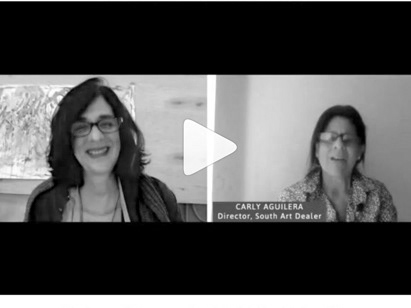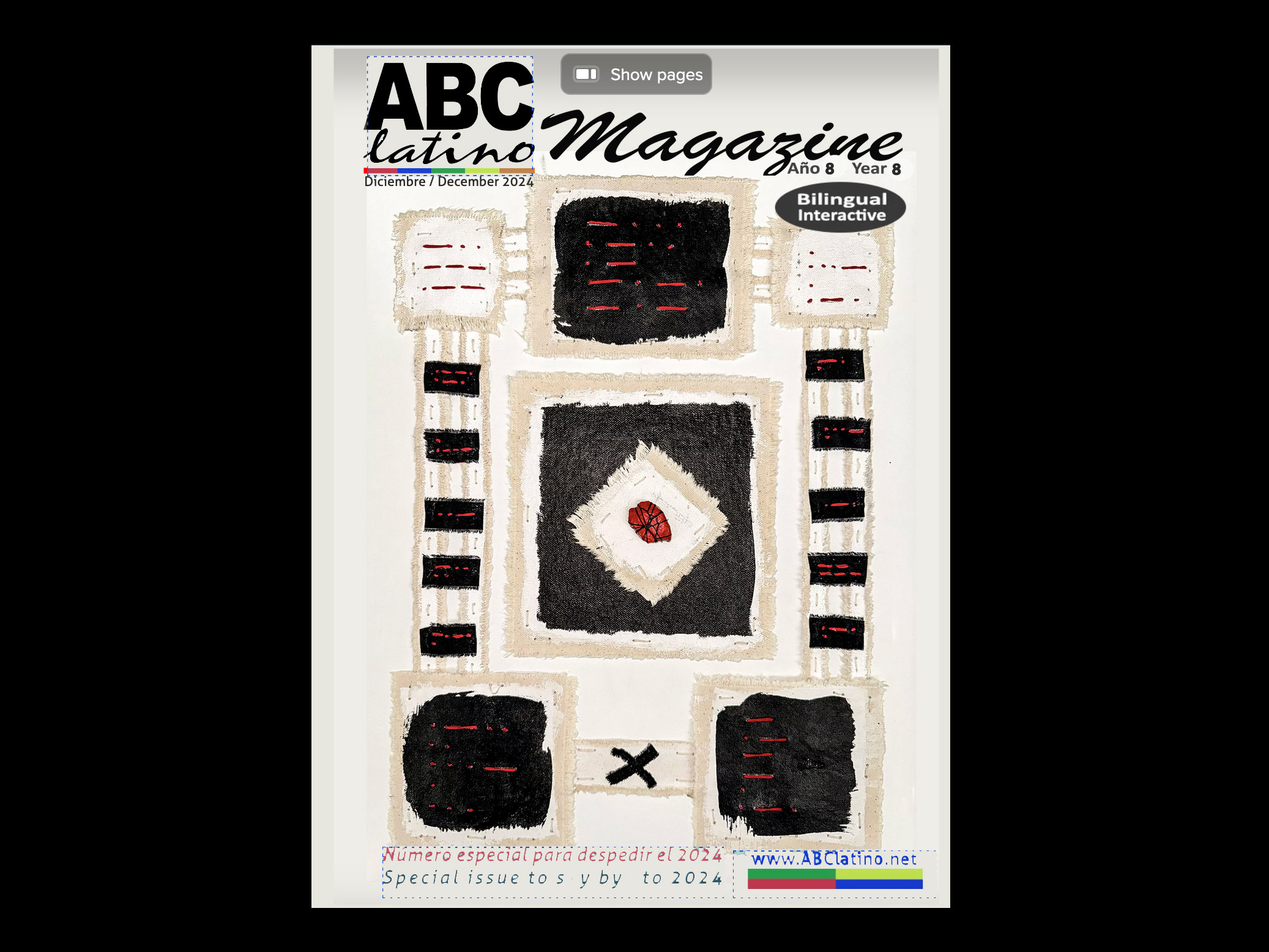Interview - English version
When and where did you begin your practice in the arts?
I started very late. It took me a while to find myself professionally. It was in 1999. I was 41 years old and lived in São Paulo. At the time she was working as an interior designer and was not happy. Something seemed wrong... Since I was little I have always drawn and painted. At school I excelled in art classes. However, when the time came to make a career decision, despite a deep desire to dedicate myself professionally to the arts, I believed that my talent might be insufficient and chose a different path.
Driven by a fascination with life itself, I chose to study Biology. Even during my university studies, I continued to dedicate myself extensively to drawing. It was during this period that I also delved into photography. I dabbled in theater, sang in a choir, and was constantly involved in artistic activities in my free time, always remaining on the periphery.
After divorcing the father of my children, I went to work as an environmental consultant at the Terra Capital Fund, the first fund in the world dedicated to supporting business projects focused on biodiversity conservation. While I had a sincere interest in the cause, working in a banking environment left me dissatisfied. Continually seeking my true purpose, I transitioned into Interior Design. However, in December 1998, I found myself at a crossroads. I realized that it does not depend on having an innate talent, but rather it is a vocation.
It is not for us to judge whether we possess the necessary talent; rather, we must follow our calling. And if it is to make art, let's make art! I left everything and decided to take a risk and follow a new path. It was an act of bravery, a leap in the dark. I started working as a cultural production assistant in a division of the São Paulo Culture Secretariat, focusing on contemporary art projects. I returned to university, earned a bachelor's degree in Visual Arts, and subsequently completed a master's degree in Fine Arts. Since 1999, I have dedicated myself wholeheartedly and without hesitation to art, fully embracing this new chapter of my life.
I started very late. It took me a while to find myself professionally. It was in 1999. I was 41 years old and lived in São Paulo. At the time she was working as an interior designer and was not happy. Something seemed wrong... Since I was little I have always drawn and painted. At school I excelled in art classes. However, when the time came to make a career decision, despite a deep desire to dedicate myself professionally to the arts, I believed that my talent might be insufficient and chose a different path.
Driven by a fascination with life itself, I chose to study Biology. Even during my university studies, I continued to dedicate myself extensively to drawing. It was during this period that I also delved into photography. I dabbled in theater, sang in a choir, and was constantly involved in artistic activities in my free time, always remaining on the periphery.
After divorcing the father of my children, I went to work as an environmental consultant at the Terra Capital Fund, the first fund in the world dedicated to supporting business projects focused on biodiversity conservation. While I had a sincere interest in the cause, working in a banking environment left me dissatisfied. Continually seeking my true purpose, I transitioned into Interior Design. However, in December 1998, I found myself at a crossroads. I realized that it does not depend on having an innate talent, but rather it is a vocation.
It is not for us to judge whether we possess the necessary talent; rather, we must follow our calling. And if it is to make art, let's make art! I left everything and decided to take a risk and follow a new path. It was an act of bravery, a leap in the dark. I started working as a cultural production assistant in a division of the São Paulo Culture Secretariat, focusing on contemporary art projects. I returned to university, earned a bachelor's degree in Visual Arts, and subsequently completed a master's degree in Fine Arts. Since 1999, I have dedicated myself wholeheartedly and without hesitation to art, fully embracing this new chapter of my life.
Do your Latin roots influence your creations?
My roots remain a vital and constant presence, nurturing and influencing my work. I was born in São Paulo to a Mexican mother and French father, and I have been intimately connected to these diverse cultures throughout my life. These cultural currents have deeply shaped my artistic identity, particularly my maternal Mexican heritage, which I have embraced through the artistic personality of Maria Palomino (my full name is Monique Marie Allain e Palomino). Some notable works signed by María Palomino include the installation titled Hibrid and the artist book “Imaginary Mexico: memories inherited, lived and invented” (digital version in English and Portuguese).
The work Híbrido is a perfect example that shows the strong influence of my South American heritage: the installation was specially conceived for the exhibition Sabores da América do Sul: Festival América do Sul, in 2014. The proposal consisted of producing a work that reflected the roots Latin American works of the artist, using as a starting point a white porcelain plate provided by the curator. I broke the porcelain plate, made a clay replacement, and embedded the porcelain shards inside. Additionally, I incorporated smaller fragments into individual ceramic granules. To reinforce the connection points between the porcelain and ceramic, I used ceramic oxide pigment along the margins where the two materials met.
The work symbolizes the hybridization and tension that characterized the interactions between the indigenous peoples of America (South, Central and North) and the European colonizers. These encounters were marked by friction, accidents, fissures, cracks and transformations as radically different cultures, customs and values collided. The act of fusing porcelain and clay sought to experiment and reify the process of immigration and colonization. The fragility of the resulting piece emerged as a natural consequence of this experimental and daring initiative. Initially, the proposal was to present the work of art in its post-firing state, regardless of the result. The result was a surprise: different materials confronted, repelled, attracted and fused into a singular hybrid piece, with cracks and scars, but rich, unique and dignified in its vulnerability. The piece was fixed to the wall at eye level, creating a horizon-like perspective for the viewer.
Another work that prominently displays my South and Central American roots is B+RT:LXN+ SXS+ from the Cipher Voice series, conceived in 2023. This piece is a tribute to the Yanomami and other indigenous communities facing adversity and mortality due to the lack of protection and support from the Brazilian government. These indigenous communities are guardians of the rainforest, which has been decimated by gold miners and farmers. The work presents the figure of Bartolina Sisa, an indigenous heroine of the 18th century, who bravely defended her people against the oppression and abuses of the Spanish colonizers. Instead of traditional feathers, her headdress is made up of plant leaves. Sisa was murdered on September 5, 1782. Since 1983, International Indigenous Women's Day has been celebrated every September 5 in honor of the date of her death. The title B+RT:LXN+ SXS+ is a coded way of writing BARTOLINA SISA, in which vowels are replaced by mathematical symbols. This use of codes is intended to engage the audience in a playful and contemplative decipherment of the message, which underlines the importance of environmental protection and the urgent need for us all to become custodians of our environment. —Editor's note: This work illustrates the cover of La Voz magazine for November 2023.
What is the main theme of your creative work?
The main theme is the search for identity, the search to discover who we are, when we are and where we belong. I believe the most effective approach to understanding yourself is through making connections. Connections with the space we inhabit (rooms and roots), with the beings that surround us (meaningful dialogues), and self-connections through immersive and introspective experimentations of situations of expanded temporality. Today I see myself as an ART(IV)IST who supports life with peace in a sustainable environment!
What materials and media do you use?
My work is multidisciplinary and multimedia. In my studio I am a magician! That's where I hide my secrets, where the “making” process happens! Dreams, fears, visions and memories mix and transform into colors, shapes and textures. I mainly use video, photography, painting and drawing. I make performances, installations and interventions, with the aim of proposing experimental situations. I explore the synesthetic potentials between different media and forms of expression.
What is your next project?
I have a very dear friend, a retired breast cancer doctor, who now volunteers at a hospital in New York. She invited me to collaborate on an artistic initiative with her patients, an idea that I immediately embraced. The central idea is to use art as a powerful tool to facilitate the healing process. Our goal is to achieve this through painting and fostering connections and conversations between hospital patients. Additionally, this project provides an opportunity for the hospital to raise funds in support of its mission. The project is expected to last one year, consisting of several meetings, culminating in an inaugural exhibition and an auction.
You can learn more about Monique Allain's work on her website and her Instagram @moniqueallain.
COPYRIGHT 2023
La Voz, Culture and Hispanic news from the Hudson Valley
La Voz, Culture and Hispanic news from the Hudson Valley

